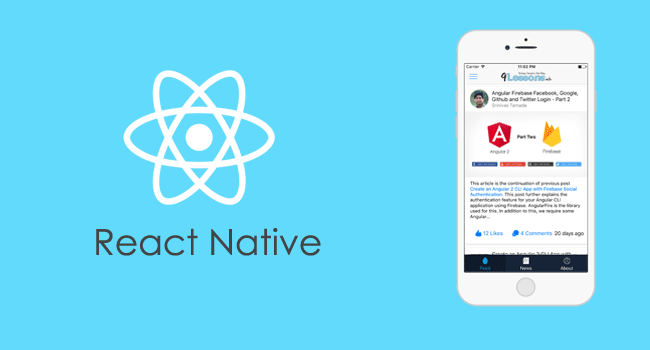When developing a mobile app, choosing the right method and tools is a difficult task. You want to deliver the smooth user experience of a native app, but you also need to get it out there as cheap and as quickly as possible.
Luckily, there are some great tools available to find the right balance. Ionic and React Native are two of the best mobile development frameworks and allow you to develop apps for iOS and Android without having to develop two completely separate apps. Let’s take a look at how they approach the problem, and which one you should be using for your mobile app.
Native and Hybrid Apps
Native apps are written specifically for their platform. That means using Java for Android apps and Objective-C or Swift for iOS. Native apps have direct access to all features of their platform, typically have the best performance, and feel great to use.
However, developing a native app is usually more expensive too. First of all, you’ll need to develop two applications – one for Android and one for iOS. Also, the knowledge required to develop in Java for Android or Swift for iOS is more specialized than HTML or Javascript. And therefore, more expensive too.
Ionic Framework
Ionic is a framework for building hybrid mobile applications that will work across all platforms. You can ‘write once, run anywhere’. It allows you to use HTML, CSS, and Javascript to develop your app. What you’re building is essentially a website wrapped up in a native application. Then, you can use tools like PhoneGap and Cordova to access native features for each platform.
React Native
React Native is developed by Facebook and takes a different approach. Facebook decided they needed a tool to develop some of their mobile applications, and shared the result with the world. It’s not quite a hybrid framework, because not all of your code can be shared between platforms. Once you’re familiar with React Native, you’ll be able to spin up high-quality applications for multiple platforms easily – so react native mobile app development is more like a mix of hybrid and native.
React Native vs Ionic Comparison
React Native and Ionic mobile development framework are designed for different purposes, meaning each has its strengths and weaknesses. Here are some of the main things to consider when deciding which platform to use for your mobile app.
Required Skills
Ionic mobile framework uses the basic web languages HTML, CSS, and Javascript to build applications. If you’ve developed a website or webapp (especially in Angular) before, you already have many of the skills you need. It’s also handy that these skills are some of the most common in the world, so you won’t have any problems finding developers to help you out.
You will need to use plugins like Cordova to access the native components, but that’s not too difficult. There are lots of premade components too so coding becomes even easier.
React Native development uses mainly Javascript. However, it’s different from Ionic in that it doesn’t use HTML or CSS to render. Instead, React will automatically render using native components on iOS and Android. This gives React applications great performance and animations. The trade off is that you can only use components that have already been written specifically for React Native. There is a good selection available, but you won’t find everything. Developers will also need to invest in learning JSX syntax instead of HTML.
Because React renders in native components, you will need to write some of your code specifically for iOS or Android. You certainly save time compared to developing native apps, but not as much as when using Ionic. Rather than “write once run anywhere”, React aims at providing, “learn once, write anywhere”. Meaning specialist developers such as devteam.space can take advantage.
Performance
Ionic is faster and simpler to develop in, but that comes at a cost. Having code that can run on iOS and Android means that it isn’t completely optimized for either platform. Therefore, the performance and animations won’t be perfect.
React Native, on the other hand, focuses on providing performance comparable with a native application. A lot of the time you won’t even be able to tell the difference. Facebook even use React Native in some of their own applications.
Both platforms are great for testing, giving you immediate feedback for any code changes you make. This fast feedback with translate into better apps with fewer bugs.
Time and Cost
Ionic will probably get your application up and run more quickly. The combination of common web skill sets, write once – run anywhere, and access to many premade components means you can whip up a prototype of your application in no time. This is great for testing your ideas, getting your MVP to the market and receiving real feedback from users.
React Native is for those who still want to build quickly, but can’t compromise on performance. Features like pinching and double tapping work just as you’d expect from a native app. Unless you’re at a big company, the slight performance and feature tradeoff will be nothing compared to the time and energy you’ll save developing with React Native. Having a single codebase will also help with iterating on your app to add and improve features as you go.
So Which Should You Use?
The winner of Ionic framework vs React Native depends on your needs. If you’ve never built an application before, or you just want to test out an idea, Ionic is probably the smartest option. It’s the fastest way to go from idea to prototype, and you’ll have no trouble finding a developer to help you out.
On the other hand, React Native is a worthwhile investment. If you’re a developer, learning the skills will pay off in the future, allowing you to build awesome apps quickly. React Native development teams will also be able to spin you up a top quality application at a fraction of the cost of a native one.




